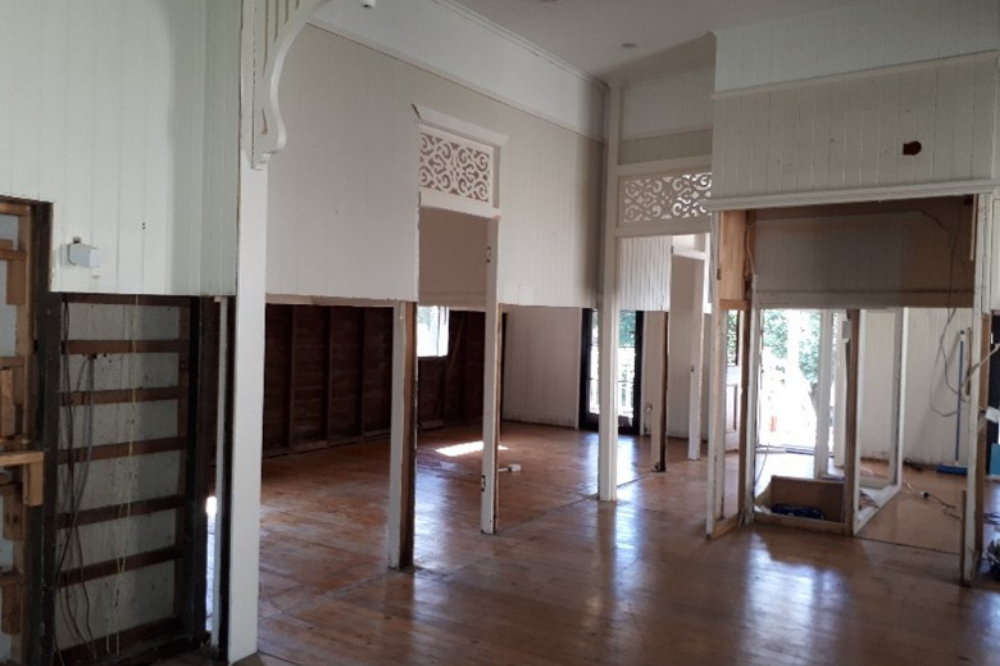

Australia’s historic houses could be another victim of the record floods.
As tens of thousands of flood damaged buildings undergo repair work, Peter Latemore (pictured) is concerned that Queenslanders, one of the country’s most iconic and loved house designs, are being unwittingly destroyed by some builders.
The result, he said, could significantly increase the cost of repair work for insurers.
“I’m just flabbergasted that someone would think it’s OK to cut away the structure of a house!” said the building designer and expert in Queenslanders. During a four-decade career, Brisbane-based Latemore estimates that he’s worked on about 2,000 of these houses.
The principal of Latemore Design said some builders are cutting away parts of water-soaked Queenslanders because they’re assuming they have structural damage or are contaminated by black water.
Latemore said these historic houses don’t absorb water or contaminants like some modern structures. He said many of the houses in the Brisbane area were in water for less than 24 hours, which isn’t enough time for a Queenslander to soak up enough to cause serious damage.
He added that this is the first serious flood event where he’s noticed this issue. He suspects that it’s because builders’ knowledge of Queenslanders is disappearing.
Read next: Broker says flooding is worst he’s seen
“There’s a diminishing number of people who have expertise in these buildings,” said Latemore.
The Queenslander expert called on insurance companies to do more to check the work they’re paying coverage for.
“I think insurers should be checking. The chain of command is breaking down,” he said.
Latemore said there’s a danger that if the insurance companies don’t correct this, they could have a second round of insurance claims on the same houses.
“If someone comes in and damages the building, how do you repair it? That’s another insurance claim,” he said.
Latemore said he was frustrated that other organizations that should be aware of this problem, like WorkSafe and associations of builders, “don’t even know it’s happening.”
The construction of a Queenslander is based on VJs (vertical joints) which are the V jointed tongue and groove boards that make up the walls inside most Queenslanders.
Latemore said that, unlike a modern timber-framed house, Queenslanders “are ridiculously dense” so it takes the frames months to soak up damaging amounts of water. So, he says there wouldn’t be structural damage from the water, and he suspects only superficial, if any, damage from contaminants.
“My God, the strength in them is remarkable!” he said. “Everyone knows if you make a box, six sides of ply, and then try to break it - you can’t. That’s what a Queenslander is like. It’s basically four to six boxes that together become incredibly strong because every part of the building is solid timber,” he added.
“So, the right thing to do is rip off all of the external boards up to the level of the flood and then blast the house with hot air, anything you can to dry it out,” said Latemore.
Latemore became concerned about the fate of these historic houses when he visited a flood impacted Queenslander house (picture below) undergoing repairs. The owner was in tears. He said the building repair work has made the building structurally unsound.

“The only thing that was holding up the house was the doorposts on either side of the doors and the windows,” he said.
The builder didn’t respond kindly to Latemore’s critique.
“It’s been destroyed,” said Latemore. “The actual only option I see that’s correct is to rip out the rest of the VJs and rebuild the house with VJs,” he said.
Latemore realized that this builder probably didn’t understand how Queenslanders were constructed and is deeply worried that other builders doing flood repair work could be equally ignorant. Anecdotally, he’s heard of a growing number of cases like the one he observed.
Latemore said part of the problem is that repair work after a flood is less restricted by building codes.
“The way the repair work occurs after a flood is there’s no need for a BA (Building Approval), often no need for a DA (Development Application), in fact, none because you’re repairing a building,” he said.
However, ironically, Latemore suspects that the extent of the structural damage being done to some Queenslanders in the name of repair work, could actually trigger a BA.
“What triggers a BA [in Queensland and also throughout Australia] usually is something like building work and that’s defined as structural in the main, or a means to produce spaces for people to live in while working,” he explained.
He said this would also trigger the need for an engineer, a certifier, other building experts and possibly a DA.
“Everyone forgets these Queenslanders have been through as many as six floods since 1893 and none of them were hacked apart and thrown away. So they will survive if you stop and think about it,” he said.
Latemore said this historic housing design was one of the major kit house technologies anywhere in the world to be done on such a large scale.
“What really exploded the building type was the Queensland government. After the First World War they had the State Advances Corporation that had sets of books every year with house designs, all architect designed, and people would just pick one and say, ‘I’ll have that house. Thank you,’” he said.
As a result, he said, “a very large proportion” of residential houses in Queensland and northern NSW built before the 1950s are Queenslanders,” said Latemore.
Many are more than a century old.
“So, they were kit houses and they just went up, literally, within a month, they were so fast.”
But post-flood repair work by builders without sufficient knowledge of this heritage could be threatening thousands of these homes.
“I’d like people to at least stop and think. Don’t walk into these houses and assume they’re the same as everything else, they’re not,” said Latemore.
